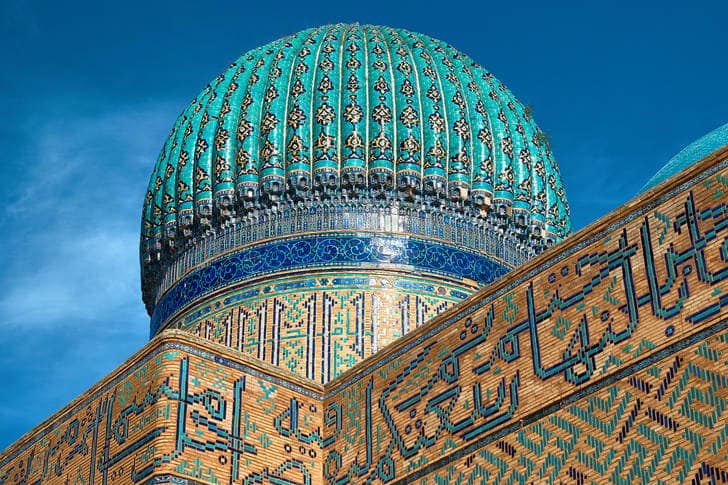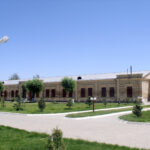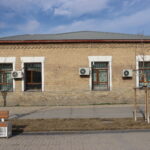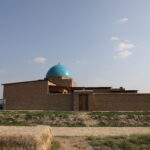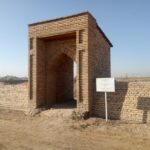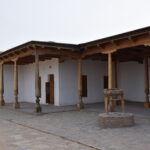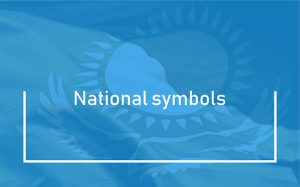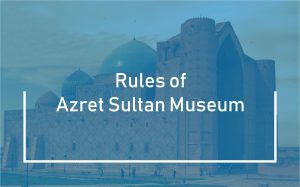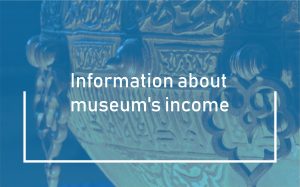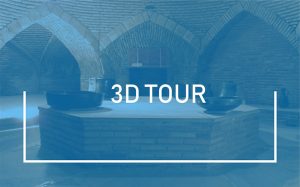The epigraphic inscription is a decorative element often used in Islamic architecture. In this context, the epigraphic inscriptions of the mausoleum of Ahmed Yasawi emphasize its artistic appearance. The inscriptions not only give the building an aesthetic appearance, but also emphasize its deep meaning.
The mausoleum of Akhmet Yasavi, which is an advanced example of medieval architecture, inspired by the best craftsmen of his time, aroused the interest of travelers, researchers and scientists who arrived in Turkestan, and served as the basis for several research papers. In this regard, the studies devoted to the epigraphic records of the mausoleum of Ahmed Yasawi can be grouped as selective and complete.
Selective studies reveal the general characteristics of the mausoleum, the legends associated with it, fragments of epigraphic writings and personal names given in it, and the translation of inscriptions on tombstones. Now let’s look at these studies.
In 1865-1866, the linguist Mirsalikh Bekchurin visited the city of Turkestan. He describes the architectural appearance of the mausoleum of Ahmed Yasawi and reports on other structures in the vicinity of this mausoleum. For example, in the mausoleum of Rabia Sultan Begim and the mausoleum of Akhmet Yasavi there are tombstones of the sultans of the Middle and Small Juz. M. Bekchurin also reads the name of Khoja Hassan Shiraz on the cornice of the mausoleum and concludes that he is the architect of this structure [1, pp. 210-217.].
On behalf of the Imperial Archaeological Commission, the orientalist archaeologist P. Lerkh visited the Turkestan region in 1867 and visited the cities of Sauran, Mirtobe and Turkestan. P. Lerkh conducted small archaeological excavations in Sauran and examined the mausoleum of Ahmed Yasawi. He photographed a copy of the inscriptions on mausoleums and tombstones next to him. He translated the inscriptions on the outside of the taykazan in this mausoleum [2; p. 9].
In 1895, scientist A. Divaev wrote down the inscriptions of the mausoleum of Ahmed Yasawi on paper and handed over data on the property inside the mausoleum to P. Akhmerov, a linguist at Kazan Imperial University [3, p. 6]. P. Akhmerov’s article «Inscriptions of the Ahmed Yasevi Mosque» contains a translation of 30 entries. Of these, 17 are inscriptions on tombstones, the rest are mausoleum objects, doors, fragments of texts on the frieze of gates and walls [4, p. 6].
In 1884-1885, the orientalist archaeologist N. Veselovsky conducted research in the Turkestan region. The scientist determines the condition of the mausoleum of Ahmed Yasawi at that time, describes the building, its rooms and doors, makes assumptions about the preserved architectural decorations and epigraphic inscriptions. Translating some epigraphic inscriptions into Russian, he notes that these are surahs of the Quran. During the study of the Turkestan region, N.Veselovsky conducted a survey of the local population about the purpose and significance of the construction of certain historical monuments [5, pp. 7-11].
During the Soviet period, M. Masson, based on materials collected during archaeological research conducted in the mausoleum in 1928, suggests that the mausoleum, erected at the end of the 14th century, was installed above the mausoleum built in the 12th century. M. Masson identified the signature and year of the work (800 AD), Khoja Hassan Shiraz is located under a niche on the eastern facade of the mausoleum, questioning M. Bekchurin’s opinion that he was the architect of the mausoleum, and concluded that «Khoja Hassan Shiraz worked on decorating the exterior of the mausoleum of Ahmed Yasawi.» The scientist also notes that the names of the masters are written on other parts and objects of the mausoleum. M. Masson discovers the name of the Shiraz master Shems Abdal Wahab in the drum under the folded dome above the tombstone and comes to the conclusion that he is the finisher of this folded dome. The scientist reports that the door hinges and several candlesticks in the mausoleum were made by the Isfahan master From et-Din bin Taj ed-Din, and the taykazan in the boiler room was cast by the Tabriz master Abdilaziz ibn Sharaf-ad-Din. In addition, he translates the entry in the upper part of the taykazan [6, pp. 12-19.].
The Orientalist A. Ivanov developed a scientific attribution of artifacts made specifically for the mausoleum of Ahmed Yasawi by order of Amir Temir, fully read the inscriptions on their exterior, studied their scientific translation and explanation [7].
It should be noted that comprehensive studies of the epigraphic inscriptions of the mausoleum of Ahmed Yasawi from 1972 to 1980. Comprehensive restoration work was carried out in the mausoleum of Ahmed Yasawi. Reconstruction of erased epigraphic inscriptions and colored patterns on the walls and domes of the mausoleum was one of the most difficult problems. On this basis, the Turkestan Scientific Restoration Workshop was established, which attracted many architects, archaeologists and chemical technologists. In particular, chemical scientist S. Takibayeva studied the composition of the paint of the facing ceramics of the mausoleum of Ahmed Yasawi. As a result, the composition of painted and unpainted glazed construction ceramics was differentiated, the mortar that binds them together, and the technology for their manufacture was determined and prepared [8, pp. 41-42].
As a result of the comprehensive restoration of the mausoleum, B. Tuyakbayeva’s work «Epigraphic decoration of the architectural complex of Ahmed Yasawi» was published. This is the first monograph devoted to the study of the epigraphic records of the mausoleum of Ahmed Yasawi. After reading the epigraphic inscriptions on the outside of the mausoleum, B. Tuyakbayeva, after consulting with Orientalists A. Ivanov and O. Bolshakov, developed a project for their reconstruction. Analyzing the architectural, planning and artistic design of the mausoleum of Ahmed Yasawi, B. Tuyakbayeva notes that there is a certain system among its architectural forms and patterns. That is, the architectural structure and decoration of the mausoleum are executed in an ideological manner, with mutual harmonization. This ideological order is evident in the arrangement of the epigraphic records. B. Tuyakbayeva notes that the epigraphic inscriptions on the Mausoleum are signed «suls» and «kufi», and divides them into three groups depending on the content: texts of the Koran, hadith and historical records (signatures of masters and years) [4, pp. 6-10].].
Considering that the above-mentioned works were differentiated, and the translations of most of them were not provided with texts written in Arabic letters, as well as not fully covered by epigraphic inscriptions and errors were sufficiently missed, an album-book «Mausoleum of Khoja Ahmed Yasawi» was developed on the initiative of the State Historical and Cultural Museum-Reserve «Aziret Sultan». A. Muminov and S. Mollakanagatuly have fully read the epigraphic inscriptions inside and outside the mausoleum, and this edition contains a scientific translation and explanations [9].
Used literature:
- Bekchurin M. S. Description of the dream of Azret, who came to the city of Turkestan / / Military collection, No. 8. 1866. – pp. 210-217.
- Lekh P. Archaeological train to the Turkestan region in 1867, St. Petersburg, 1870 – 39 p.
- Divaev A. Tartu. – — A., 1992. — 204 p.
- Tuyakbaeva B. T. Epigraphic decoration of the architectural complex of H. A. Yasavi. – A., 1989. -176 p.
- Kozha B. N. I. Veselovsky on the customs of Southern Kazakhstan // Bulletin of MITZAI. – 2008. — Issue No. 8. — Pp. 3-13.
- Masson M. E. Mausoleum of Khoja Ahmed Yasawi. — T., 1930. -28 P.
- Ivanov A. A. About the bronze product of the Late 14th century. Mausoleum of Khoja Ahmed Yasawi / / Central Asia and the Middle East, Moscow, 1981, 155 p.
- Tuyakbaev K. Restoration — the art of modernization. – A., 2007. — 68 p.
- Mausoleum of Khoja Ahmed Yasawi. Mausoleum of Khoja Ahmed Yasawi. Mausoleum of Khoja Ahmad Yasawi / comp.»I do not know,» he said. — A., 2013. — 208 p., in Kazakh, Russian, English.
Atabayeva, scientific supervisor

